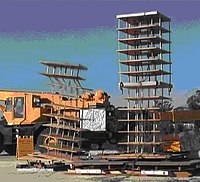
Photo from wikipedia
Abstract This study analyzed the land deformation associated with Mw 6.3 earthquake along Pasni coast, Pakistan. Post-earthquake widespread surface displacements were found using Sentinel-1 data. Pre, Co and Post-seismic images… Click to show full abstract
Abstract This study analyzed the land deformation associated with Mw 6.3 earthquake along Pasni coast, Pakistan. Post-earthquake widespread surface displacements were found using Sentinel-1 data. Pre, Co and Post-seismic images were used to investigate the deformation trends. Before the earthquake, 89.65% of Pasni land mass showed uplifting from 0.0 to 3.0 cm at 1.00 mm/day while 3.0 cm subsidence was noted in 86.36% of the land mass after the earthquake at 2.5 mm/day. However, two weeks after the earthquake, 72.9% Pasni land mass showed uplifting at an unprecedented rate of 3.3 mm/day. The maximum deformation along the Line Of Sight (LOS) direction in co-seismic time was about -4.0 cm. Azimuthal interferogram showed more complex displacement pattern with both negative and positive displacements between ±5.0 cm. Pasni is already facing many problems due to increased sea water intrusion under prevailing climatic changes and land deformation due to strong earthquakes.
Journal Title: Geocarto International
Year Published: 2019
Link to full text (if available)
Share on Social Media: Sign Up to like & get
recommendations!